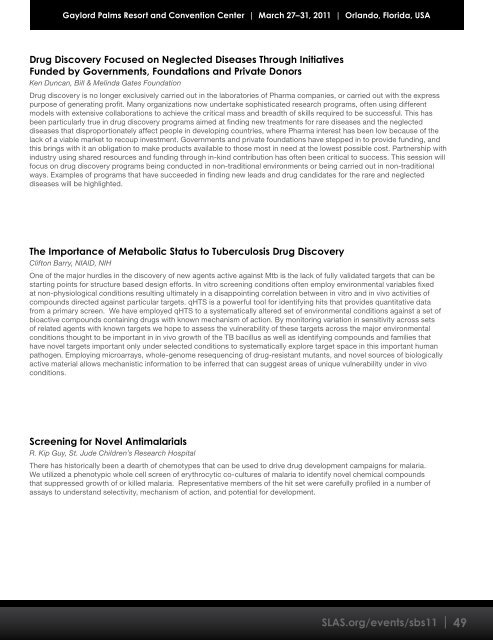Create successful ePaper yourself
Turn your PDF publications into a flip-book with our unique Google optimized e-Paper software.
Gaylord Palms Resort and Convention Center | March 27–31, <strong>2011</strong> | Orlando, Florida, USA<br />
Drug Discovery Focused on Neglected Diseases Through Initiatives<br />
Funded by Governments, Foundations and Private Donors<br />
Ken Duncan, Bill & Melinda Gates Foundation<br />
Drug discovery is no longer exclusively carried out in the labora<strong>to</strong>ries of Pharma companies, or carried out with the express<br />
purpose of generating profit. Many organizations now undertake sophisticated research programs, often using different<br />
models with extensive collaborations <strong>to</strong> achieve the critical mass and breadth of skills required <strong>to</strong> be successful. This has<br />
been particularly true in drug discovery programs aimed at finding new treatments for rare diseases and the neglected<br />
diseases that disproportionately affect people in developing countries, where Pharma interest has been low because of the<br />
lack of a viable market <strong>to</strong> recoup investment. Governments and private foundations have stepped in <strong>to</strong> provide funding, and<br />
this brings with it an obligation <strong>to</strong> make products available <strong>to</strong> those most in need at the lowest possible cost. Partnership with<br />
industry using shared resources and funding through in-kind contribution has often been critical <strong>to</strong> success. This session will<br />
focus on drug discovery programs being conducted in non-traditional environments or being carried out in non-traditional<br />
ways. Examples of programs that have succeeded in finding new leads and drug candidates for the rare and neglected<br />
diseases will be highlighted.<br />
The Importance of Metabolic Status <strong>to</strong> Tuberculosis Drug Discovery<br />
Clif<strong>to</strong>n Barry, NIAID, NIH<br />
One of the major hurdles in the discovery of new agents active against Mtb is the lack of fully validated targets that can be<br />
starting points for structure based design efforts. In vitro screening conditions often employ environmental variables fixed<br />
at non-physiological conditions resulting ultimately in a disappointing correlation between in vitro and in vivo activities of<br />
compounds directed against particular targets. qHTS is a powerful <strong>to</strong>ol for identifying hits that provides quantitative data<br />
from a primary screen. We have employed qHTS <strong>to</strong> a systematically altered set of environmental conditions against a set of<br />
bioactive compounds containing drugs with known mechanism of action. By moni<strong>to</strong>ring variation in sensitivity across sets<br />
of related agents with known targets we hope <strong>to</strong> assess the vulnerability of these targets across the major environmental<br />
conditions thought <strong>to</strong> be important in in vivo growth of the TB bacillus as well as identifying compounds and families that<br />
have novel targets important only under selected conditions <strong>to</strong> systematically explore target space in this important human<br />
pathogen. Employing microarrays, whole-genome resequencing of drug-resistant mutants, and novel sources of biologically<br />
active material allows mechanistic information <strong>to</strong> be inferred that can suggest areas of unique vulnerability under in vivo<br />
conditions.<br />
Screening for Novel Antimalarials<br />
R. Kip Guy, St. Jude Children’s Research Hospital<br />
There has his<strong>to</strong>rically been a dearth of chemotypes that can be used <strong>to</strong> drive drug development campaigns for malaria.<br />
We utilized a phenotypic whole cell screen of erythrocytic co-cultures of malaria <strong>to</strong> identify novel chemical compounds<br />
that suppressed growth of or killed malaria. Representative members of the hit set were carefully profiled in a number of<br />
assays <strong>to</strong> understand selectivity, mechanism of action, and potential for development.<br />
<strong>SLAS</strong>.org/events/sbs11 | 49

















